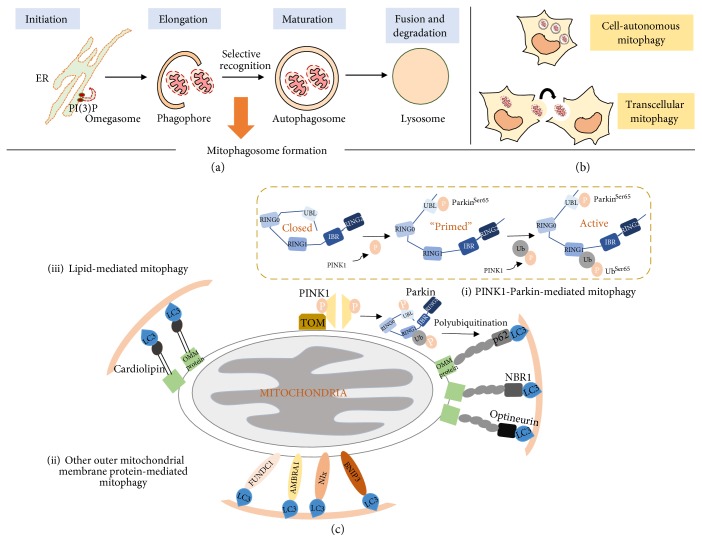Figure 1.
Different mechanisms of mitophagy. (a) Autophagy cascade showing initiation of autophagosome membrane formation from endoplasmic reticulum (omegasome), elongation of the early autophagosome membrane (phagophore), engulfment of mitochondria into the matured autophagosome to form mitophagosome, and final fusion with lysosome for degradation. (b) Mitophagy can occur intracellularly (autonomous) or via a transcellular process where damaged mitochondria are exported to neighbouring cell for degradation by mitophagy. (c) (i) The most well-studied mitophagy pathway is mediated by PINK1 and Parkin. Under mitochondrial stress, PINK1 is stabilized on the outer mitochondrial membrane (OMM) where it associates with the TOM complex. Subsequently, PINK1 undergoes dimerization and autophosphorylation to promote recruitment of Parkin to the OMM for its activation. Under physiological conditions, Parkin adopts a closed confirmation and is kept inactive due to the association between its UBL and RING1 domain. Mitochondrial membrane depolarization causes PINK1 to phosphorylate Parkin at Ser65 which perturbs the UBL-RING1 association. PINK1 mediates a second phosphorylation event on the ubiquitin (Ub) molecule at Ser65 to fully activate the E3 ligase activity of Parkin through phosphorylated UbSer65 binding. Activated Parkin ubiquitinates OMM proteins via K27 or K63-linked polyubiquitination to serve as recognition tags to recruit cargo adaptor proteins like p62, NBR1, and optineurin for selective targeting of mitochondria into the autophagosome. OMM proteins can also directly bind phosphorylated UbSer65 to recruit cargo adaptors. (ii) OMM proteins such as BNIP3, NIX, FUNDC1, and AMBRA1 also possess the LIR motif and can interact directly with LC3 to facilitate selective targeting of the mitochondria to the autophagosome. (iii) Lipid moieties on the OMM can alternatively bind LC3 independent of cargo adaptor proteins. For example, phospholipid cardiolipin has shown to translocate from the inner mitochondrial membrane to the OMM to recruit LC3.

